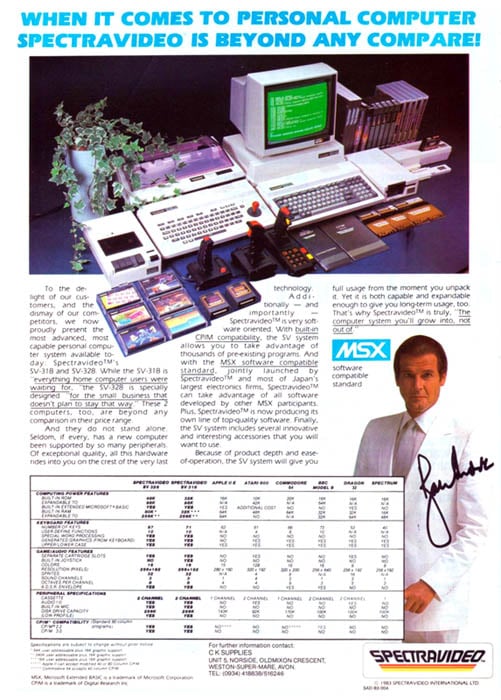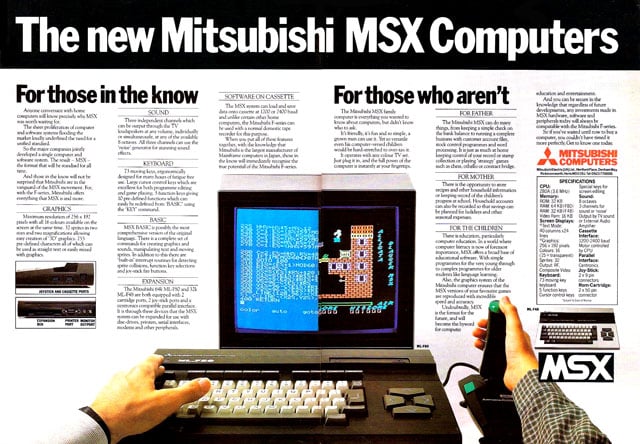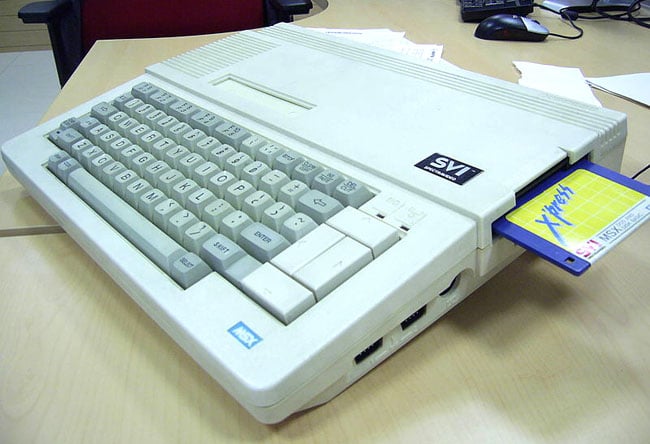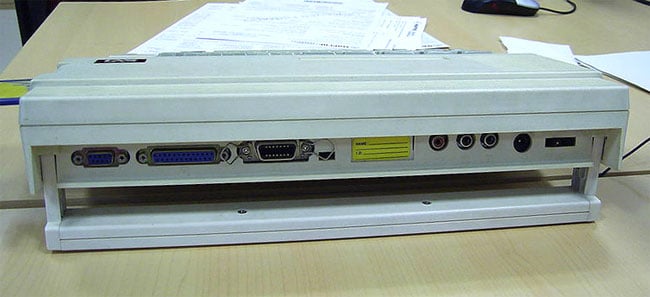Original URL: https://www.theregister.com/2013/06/27/feature_30_years_of_msx/
MSX: The Japanese are coming! The Japanese are coming!
The first would-be home computing standard... 30 years on
Posted in Personal Tech, 27th June 2013 13:27 GMT
Archaeologic MSX: three initials that struck fear into the heart of Britain’s nascent home computer industry. The Japanese were coming, and the UK’s technology pioneers were anxious about what that might mean. Far Eastern firms like Sony, JVC, Sanyo and Pioneer had put paid to Britain’s mass-market hi-fi makers, and others had killed the British motorcycle, camera and watch industries. And now they might do the same for our computer companies.
But the folk at Sinclair, Acorn, Oric, Dragon, Camputers and co. need not have worried. MSX and the companies backing the standard would never have the impact the natives feared it might. But their initial fears were not unreasonable: the cards appeared stacked in the invaders’ favour.
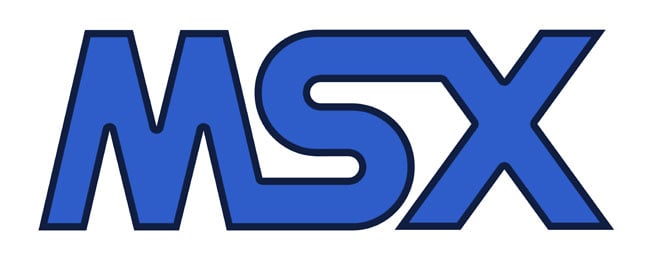
The Japanese firms were pitching a single core hardware and software platform, ensuring full application and games compatibility across machines from different manufacturers, almost all of them with a strong reputation for product quality and aggressive pricing. And Microsoft, developer of the nearest thing back then to a standard dialect of Basic, was behind it too.
What could possibly go wrong?
Microsoft formally announced the MSX platform on 16 June 1983. Eleven days later, Canon, Fujitsu, Hitachi, JVC, Mitsubishi, National, Sanyo, Sony, Toshiba, Yamaha and other Japanese firms, plus Korea’s Goldstar - now LG - and US-Hong Kong company Spectravideo announced they would support the new would-be standard. Most would ship kit in Japan well before the year was out.
But the origins of MSX go back two years before that, to 1981 and the August launch of the IBM PC, aka the 5150. Existing and current home machines contained 8-bit processors, but the IBM 5150’s Intel 8088 processor was a 16-bit part. Even though the 5150 had been designed for business users, it was seen by many observers as the beginning of the end of the era of 8-bit microcomputing, established in the mid-1970s.
Or so thought Kazuhiko “Kay” Nishi, co-founder of the Ascii Corporation, a Japanese computer magazine publisher which broke into the software distribution business in the late 1970s. By the early 1980s it was established as the de facto Microsoft Japan. Nishi himself had become Microsoft's VP for Far Eastern operations. He realised all computers would soon make the shift to 16-bit computing, but there was just time to define “a final, ultimate 8-bit machine”.
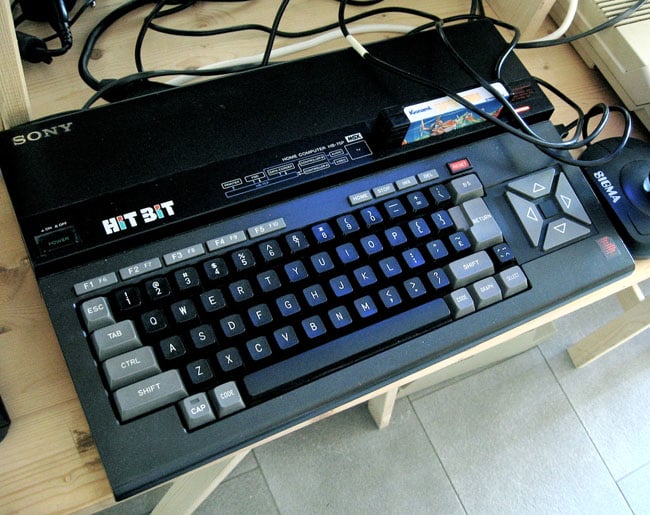
Hit or miss? One of Sony’s first MSX machines, the Hit Bit HB75
Source: Marcin Wichary
Not just a machine that stood alone, either, but one that would be the foundation for a platform.
“I realised that our IBM Basic would be the standard for business and that lots of manufacturers would make micros that were IBM compatible,” he said a few years after the debut of MSX. “I thought that we could take that concept further in the home market.”
The surge of interest in the IBM PC quickly led to compatible machines from rival vendors, who took Microsoft’s own-brand version of the operating system, licensed to IBM, and combined it with Intel processor technology and a compatible third-party Bios to produce “IBM clones” that would run applications and utilities written for the 5150.
If a common platform for business computing could be established around a Microsoft product and a core hardware specification, then why, Nishi reasoned, could the same not be true of the home computing market? And thus was born the notion later enshrined in MSX - short for "Machines with Software eXchangeability", Nishi has always insisted.
But the idea ran deeper: to develop a platform consumer electronics companies could build into their more mainstream offerings. Firms like Panasonic and Sony, Nishi said, as big producers of television sets, could decide to put a computer capability into each TV. “In the case of Yamaha, it is a very large keyboard manufacturer so it integrates the computer into a keyboard,” said Nishi. In each case, MSX could be that computer. It could be, he thought, the basis for what we today would call a "smart" device.
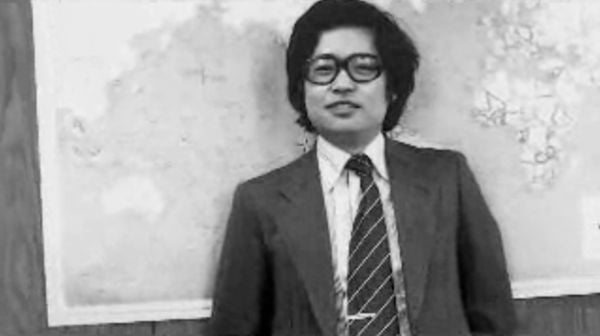
MSX man: Kazuhiko Nishi in the late 1970s
Source: YouTube
Bill Gates was keen. And could see a broader scope. Just a few years later he forecast: “By having a standard interface between software and hardware, where the hardware is very high volume, the chip companies can go off and build specialised chips that take the functions that in MSX were originally done with 20 chips and slowly work that down to a single chip so the price of the product can be low enough that it’ll be built into TV sets some day.”
During the summer of 1982, however, MSX was still unnamed and undefined. It’s at this point that Spectravideo - a US company formed in 1981 and run by two Americans, Alex Weiss and Harry Fox, but operating out of Hong Kong - enters the story. Spectravideo was designing a low-cost home micro to compete with Atari, Commodore and Texas Instruments in the States. It needed a version of Basic and turned to Microsoft to supply it. Being based in the Far East, it naturally ended up dealing with Nishi. A deal was struck, and Spectravideo appointed one Steve Ting to liaise with Microsoft.
Ting worked closely with two Ascii-Microsoft programmers known now only as Rick and Jay, and pushed them to combine the best elements of Microsoft’s existing home computer-oriented Extended Colour Basic and of the 16-bit GW Basic it had written for the IBM PC. The result, codenamed "Cornflake", would eventually become SVI Basic to Spectravideo and, to Microsoft, MS Basic 4.5.
From Spectravideo to MSX
By the winter of 1982/1983, Spectravideo had its hardware designed. It wasn’t quite the $100 machine that Weiss and Fox had hoped to offer, but it had become a product that could also be pitched at businesses. So two versions were devised: a basic model and one with a better keyboard and more memory.
Nishi saw in the Spectravideo core specification the basis for the home computer platform he’d been thinking about for more than a year. He began pitching the idea to the various Japanese consumer electronics companies which had also begun approaching Microsoft in order to license its version of the Basic programming language for home micros they were planning.
Among them, Sony and Matsushita - now called Panasonic, though it later released MSX computers under both its Panasonic and National brands - took a particular interest in Nishi’s notion and agreed to work closely with Microsoft to build a common platform.
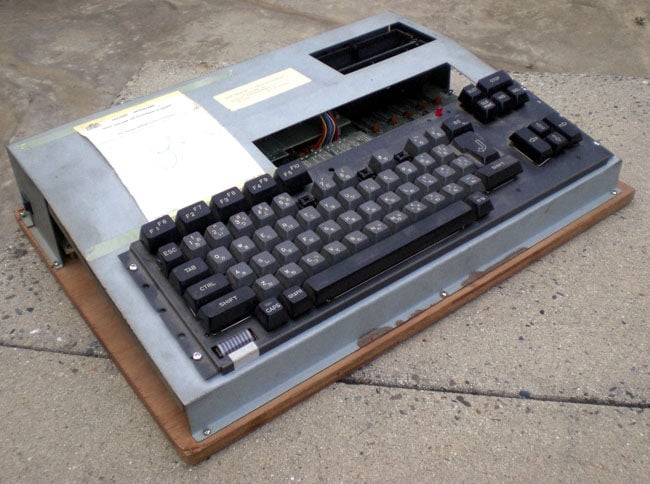
An MSX prototype, said to be Kazi Nishi’s own
Source: Bruce Damer/Digibarn
Coming from the TV and hi-fi markets, these firms understood the idea of selling hardware based on recording media standards and could easily extend the concept to computers. They believed that compatibility - the way any tape deck could play any pre-recorded cassette, say - would drive sales to such a degree that there would be a market for all vendors’ kit, and there would be no need for aggressive, ungentlemanly head-to-head competition for hardware sales.
It might work out cheaper too. “Once MSX is available worldwide the manufacturers will be able to spread their development costs over a large volume of sale,” said Nishi in 1984, undoubtedly echoing conversations he’d had with hardware vendors. “The cost of developing peripherals for MSX is low because any add-on product works on more than 20 makes.”
SVI Basic subsequently became MSX Basic when the new platform’s branding had been defined. Microsoft’s deal with Spectravideo clearly made this possible and, indeed, the US-Hong Kong company was an early, enthusiastic supporter of the MSX brand and platform.
The platform Spectravideo came up with, and which was later refined by Nishi and his Japanese hardware partners, comprised the popular buy ageing 8-bit Z80A processor clocked to fractionally less than 3.6MHz. It was combined with a Texas Instruments 9918 display chip and a sound processor from General Instruments, the AY-3-8910, for eight-octave, three-channel sound routed through the connected TV’s speaker. An Intel 8255 Programmable Peripheral Interface chip handled the I/O.
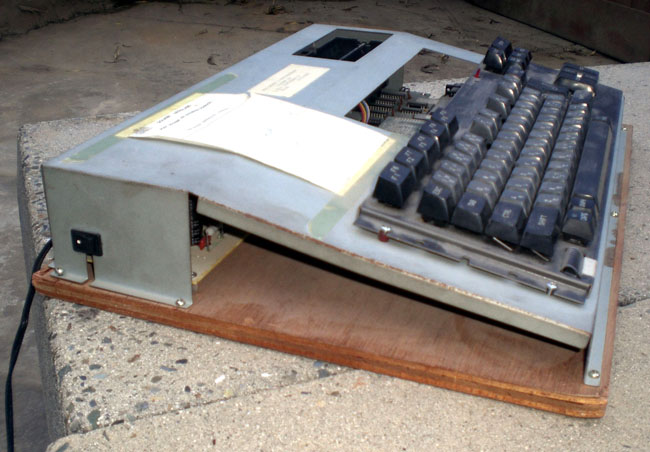
Source: Bruce Damer/Digibarn
Those last three chips would, in a UK-designed micro, have been combined into a single custom silicon part called a ULA, short for “Uncommitted Logic Array”, cheaply made and, thanks to the integration, needing less motherboard space than umpteen separate chips. This was one reason why some MSX machines ended up so much pricier that many of their British rivals.
Others used the so-called MSX Engine chip, a Yamaha-made part which combined the capabilities of the GI sound chip, the Intel 8255 and other peripheral-control logic. That helped reduce costs, a little.
MSX machines also had to have 32KB of Rom for Microsoft’s Extended Basic, at least 8KB of Ram for user programs and 16KB of Ram for the video buffer. The TI 9918 chip would provide 16-colour graphics on a 256 x 192 display, though each byte’s worth of eight pixels could support only two colours; the 16-colour values were presumably stored as four-bit numbers, two per byte. Thus, 12KB for the pixel map and colour value bytes in total.
In addition to the hi-res screen, Microsoft’s MSX Basic supported separate 40 x 24 - the bottom three rows were dedicated to on-screen labels indicting function-key assignments - and 32 x 24 text-only modes, and a low-res, 64 x 48 graphics mode. It would also allow up to 32 programmable sprites.
A cassette interface would come as standard on MSX computers, as would an Atari-style joystick port and a Rom cartridge slot.
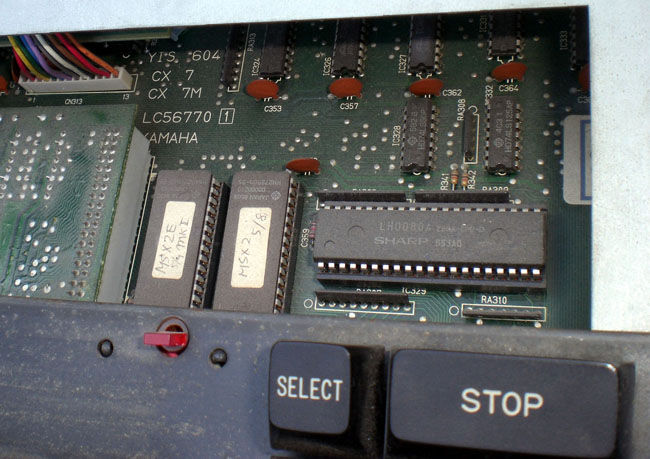
MSX 2 Roms - basic and extended - in Nishi’s prototype
Source: Bruce Damer / Digibarn
It wasn’t just the internals that the MSX specification determined: all MSX-branded machines had to have four large cursor keys, which most of the micros placed to the right of the keyboard. There had to be ten function keys, too, typically placed above the keyboard, with the Shift key making five physical keys operate as ten. Certain function keys were to be mapped to MSX Basic commands, including GOTO, LIST and RUN.
The Qwerty deck itself had to incorporate special Graph and Code modifier keys for graphical characters and other glyphs. Clear Screen/Home, Insert and Delete keys helped with program editing, while Select and Stop could be use within code to improve user interaction.
“Japanese policy is obvious,” wrote Max Phillips in the weekly Personal Computer News following the 27 June launch. “MSX was designed for Japan’s own home market where a lack of software was damaging the growth of home computers. MSX turns home computers into record players... the software becomes interchangeable.
“On a wider scale, MSX may give all but the UK’s top producers a hard time. Software houses will see little point in writing for non-standard machines with small user bases. With MSX, they can write one program for a whole range of machines. Sounds unlikely? CP/M offered far less compatibility [than MSX] but you’d be hard put to find a top-selling 8-bit business machine without it.”
Would-be world standard
Would the punters prefer that to the then current array of largely incompatible home-grown micros? Sinclair Research’s then MD, Nigel Searle, was sceptical. He told Your Computer in 1984 that he believed Microsoft’s standardisation drive had come too soon. Better, he said, to wait for the next-generation of home machines based on 16- or 32-bit processors. Prescient thinking or fear-induced bluster?
Meanwhile, the MSX machine began to move. Microsoft announced a MSX-centric version of MS-DOS semi-compatible with Digital Research’s CP/M operating system, to be called MSX-DOS of course, in October 1983. It had been put together by MS-DOS’ original writer, Tim Paterson, back in Seattle. At the same time, the first six machines from Japanese vendors were introduced at the Japan Data Show.
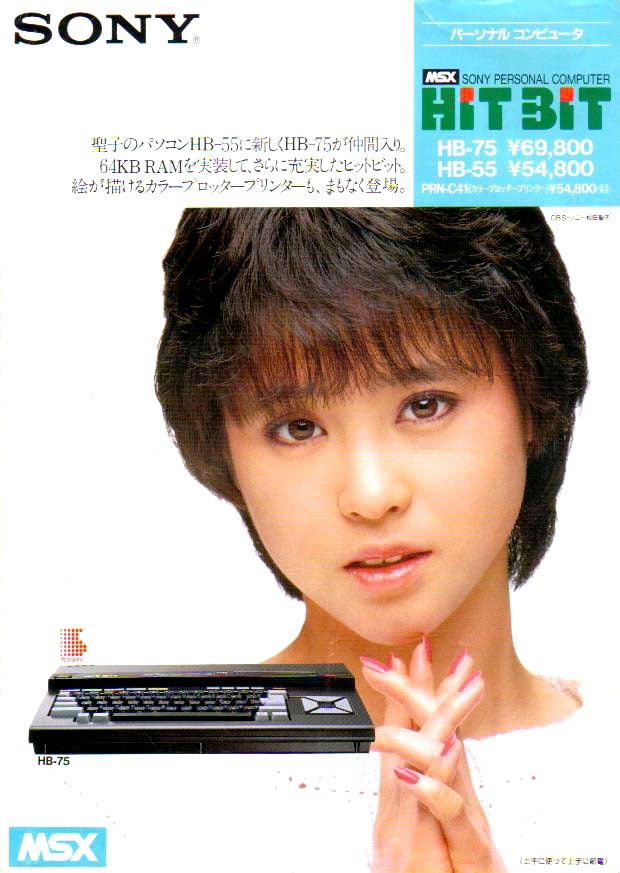
Big in Japan: Sony's MSX machines were among the more popular offerings
US-based Spectravideo had already announced its first MSX machines, in the States at least, and launched them during the latter part of 1983. Its two offerings were the SVI 318 and the SVI 328, the former a £199 micro with a built-in joystick, 32KB of Ram - 16KB of which, remember, was dedicated to the graphics as per the MSX spec - and 32KB of Rom.
The £275 SV328 came with a total of 80KB of Ram and 48KB of Rom. It lacked the cheaper machine’s joystick but in keeping with its higher price and emphasis on more serious users, it had a separate numeric pad alongside the keyboard.
Both machines required a dedicated cassette recorder - a trick pioneered by fellow US vendor Commodore - and Spectravideo offered a range of the accessories, including disc drive and Centronics printer interface add-ons, and Ram expansion cards.
All well and good, except that Spectravideo’s machines were not fully compatible with the MSX specification. They had, after all, been devised before the MSX specification had been nailed down. When the news made it to the UK, an understandably peeved Tony Noble, head of computer dealer The Gamekeeper, the company retailing the bulk of Spectravideo imports, told PCN: “We nearly sent the whole lot back.”
Spectravideo’s UK distributor, Weston-Super-Mare based CK Supplies, grumbled that it had been “misinformed” by the manufacturer, which, it said, had proclaimed full MSX compatibility in all of its adverts up to that point.
Spectravideo itself said its machines were true to the MSX specification as originally defined, and that it wasn’t the companies fault that the standard had changed after it had put its machines into production. CK promised a £30 adaptor to fix the Rom slot incompatibility. Spectravideo itself would eventually release a fully compatible MSX machine, the 728, in the autumn of 1984.
By January of that year, all of the machines were on sale in Japan, but few had appeared over here yet. They were unveiled to major UK retailers at a special event held early in February alongside the British Toy and Hobby Fair trade show, and it was becoming clear that most of the machines - if not all of them - would not be widely available here for another six or seven months.
Indeed, to help keep the platform in the mind of the public, the array of incoming Sonys, Toshibas, Yamahas et al were once again shown off, this time to the press, in May.
Of course, while the prices of the machines had originally been forecast to be under £200, by now MSX manufacturers were simply saying that prices would be “competitive”. But British backers of the standard, gathered together under Toshiba’s leadership as the MSX Working Group, were by now claiming all the key UK software vendors, among them Psion, Quicksilva, Virgin, Melbourne House, Thorn EMI, Silversoft and Hewson, were working on games for the platform. Bug-Byte, Kuma, Aligata, Ocean and Ultimate were said to be considering jumping in too.
Some insiders, however, claimed software developers had been bullied into developing MSX games by the platform’s fans within major UK retail chains.
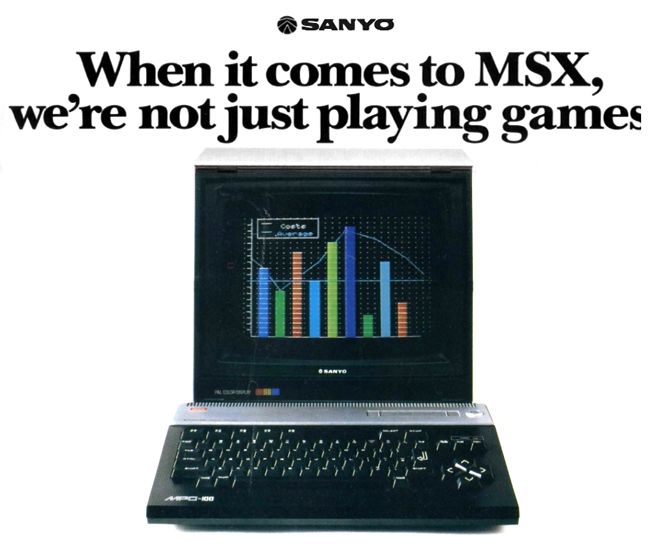
Sanyo pitches its MCP-100
No wonder hardware companies were beginning to wonder whether they should come on board too. There had already been one or two rumours that troubled Welsh micro-maker Dragon Data was planning to release an MSX machine; its parent, GEC, was one of seven other European firms known to be talking to Microsoft about licensing MSX.
“Our view at the moment is that MSX in the way we will go,” Dragon marketing executive Kevin Stephens told Popular Computing Weekly. “If so, we will almost certainly also be doing software for MSX.”
Within weeks, however, GEC had called the receivers in to administer Dragon Data’s sale or closure. GEC indicated it still planned to seek an MSX licence, but such a move would come to nought. In October, GEC said an MSX machine was no longer on the cards while the company considered whether it wanted to be involved in the home computer market at all.
“Originally, we planned to bring out the MSX computer this autumn,” GEC Radio and TV marketing manager Dennis Judd told Popular Computing Weekly at the time. “However, we were unable to obtain sufficient supplies and as a result have shelved the whole project.”
Athletic support
Perhaps the departure of Dragon’s core technical team to Thorn EMI, where they would produce the Liberator laptop, had something to do with the decision. Derek Williams, who was Dragon’s Technical Director and one of those who jumped from the sinking company to join Thorn, says Dragon did briefly consider the platform but that no development project was ever drawn up. The company was more keen to break into the business market with a 16-bit system based on the Motorola 68000 processor, and focused its energies there.
Oric would later likewise talk up its efforts to develop an MSX machine in the weeks before it went tits up early in 1985. Oric’s MSX machine was never seen, but a Dragon MSX prototype was put together. Not by Dragon, but by Hong Kong hardware company Radofin, which had designed the Mattel Aquarius. Several of these are believed to have been assembled for Dragon’s subsequent owner, Spain’s Eurohard. When Eurohard too when tits up, it handed out its few Dragon MSX boxes to workers in lieu of salaries.
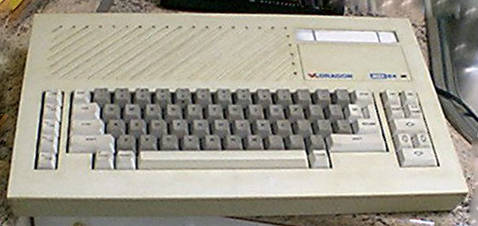
Very rare beast: Eurohard’s Radofin-made Dragon MSX
Source: Miguel Durán
Philips was another European company that expressed an interest in MSX, though it kept quiet about it through most of 1983 and 1984. It finally came clean in September that its “MSX machine is now ready”, according to company product marketing manager Sixto Rodriguez, who spoke to Popular Computing Weekly. In the end, Philips would stay out of the UK market, releasing its VG 8000 box in the Netherlands, Italy, Germany and France.
Back in Japan, MSX manufacturers agreed to use Sony’s 3.5-inch floppy disk format, to be controlled by MSX-DOS. “A disk format standard is a fundamental part of the thinking behind MSX and it is inevitable that one of us has to lose out,” admitted Alan Geekie of Hitachi UK, which had been hoping its own, 3-inch floppy format would be selected for MSX.
MSX formally launched in the UK at the end of September 1984, 15 months after MSX’s own launch and almost a year after kit began appearing in Japan. Canon, Hitachi, JVC, Mitsubishi, Sanyo, Sony and Toshiba all released kit, but now priced closer to £300 than the £200 price point the platform had originally been pegged to. More than 50 software houses had committed themselves to supporting the platform, the MSX Working Group claimed, including all the big names.
By now, Casio had licensed MSX and released a machine in Japan. Brother and Sharp had also agreed to support the platform. So had Japanese camera company Yashica and even videogames pioneer Sega was getting in one the act, announcing in October 1984 the Yeno DPH-64, the follow-up to its Z80A-based Yeno SC3000, some 120,000 of which were sold in Japan during 1983 though it was never brought to Britain.
UK buyers were offered the Spectravideo SV 728, a version of the 328 updated for full MSX compatibility and released over here in the autumn of 1984. Ditto the Goldstar MSX, brought to the UK by Micro Dealer. Goldstar is now better known as LG.
These two joined the Sanyo MPC 100, Sony Hit-Bit HB-55, Toshiba HX-10 and the Yamaha CX-5. Other backers, including Canon, JVC and Mitsubishi, decided to hold back and release their machines here toward the end of the year, the better to take advantage of pre-Christmas sales and to await the arrival of more games software.
Yamaha offered its CX-5 and, later, YIS 50311 through music shops, making use of a bundled three-and-a-half octave piano keyboard, a MIDI interface and an on-board synthesiser to pitch the computer at musicians.
Sir Clive Sinclair was dismissive: “[MSX is] certainly not a commercial threat to us,” he said in response to television’s Tony Bastable on 1984 ITV show Data Base. “It’s quite clear what has happened here: Japan and America have both, strangely as it may seem, failed to do anything like as well as Britain in the personal computer business... Japanese companies like Sony and many others have tried again and again to enter the British market and succeed here... and they haven’t done very well.
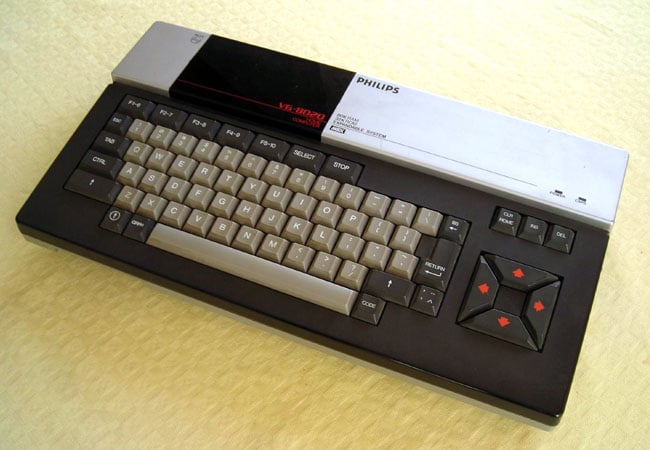
Phillips’ VG8020
Source: Audrey and Max
“So they got together to form a common standard, and they’ve had that common standard in Japan for a year or so [but] what should be realised is that all those companies together, all of them throughout Japan, make fewer computers than Sinclair Research on its own.
“It’s like if all the car manufacturers got together and said, ‘Let’s all have the same engine, the same gearbox, the same axle and let’s use the one designed five years ago, wouldn’t that be great?’
“Nobody will have to bother about it: they’ll all take the same parts, but it’ll be a five-year-old card and they’ll all be the same.”
Favourable reception
Reviewers were generally more favourable toward the MSX machines, praising the platform’s implementation of Basic and the platform’s mandated software compatibility, but were critical of the ageing hardware specification and its relatively high price.
“Microsoft has done a good job in providing a powerful and clean Basic,” wrote Glyn Moody in Your Computer’s November 1984 issue. “Everything you would expect from a reasonably structured Basic is there, along with powerful sound, graphics and sprite commands... Editing is carried out simply and efficiently using the cursor, insert and delete keys.”
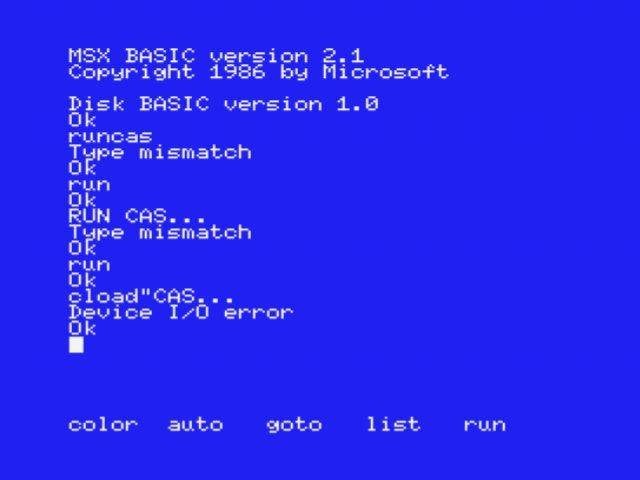
MSX Basic boots
MSX Basic had some novelties, most notably its trigger commands, including INTERVAL, KEY, SPRITE and STRIG, allowing programs to jump to subroutines at, respectively, set time intervals, on joystick trigger presses, on key presses and when sprites collide. A fifth command, STOP, was triggered when the Stop key was pressed.
Separately, VPEEK and VPOKE applied the notion behind the commonplace PEEK and POKE commands to the video Ram.
“In ordinary loops and GOTOs, the MSX machines emerged as about half as fast as the BBC [Micro] and twice as fast as the Spectrum. But in one speed check designed to test the maths routines - such as calculating sines, logs and so on - the MSX micros were markedly slower. This is mostly due to the fact that they work to 14-digit precision. This is hot stuff for a home micro, but the penalty you pay is loss of speed in intensive number crunching activities.” Other Basics used ten-digit precision.
Anticipating the imminent arrival of an eager fanbase, UK publishers began to lay out their stalls for MSX titles, among them Argus Specialist Press’ MSX User, and What MSX? and MSX Computing, both from Haymarket and published on alternate months.
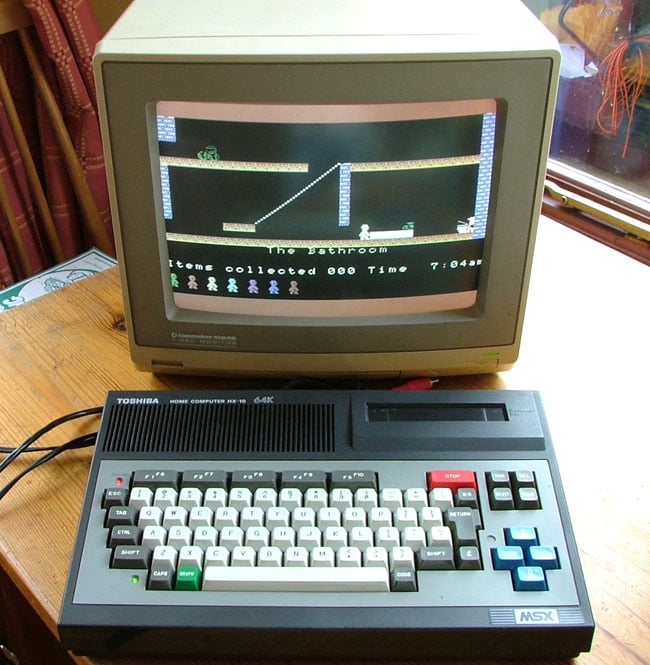
Toshiba’s HX-10
Source: Quagmire
“You’re going to hear so much about MSX in the future that it will become as much a part of your vocabulary as Hoover, Sellotape or VHS,” said What MSX? magazine. “In the not-too-distant future, the MSX computer is going to be as much a part of the home as the telephone, the television and the car.”
By the autumn of 1984, a year on from MSX’s Japanese launch, the format had about 15 per cent of the Japanese micro market running from home machines to business desktops, based on the number of machines sold, What MSX? reported. According to MSX User, the format’s share of the Japanese home computer market stood at almost 40 per cent.
Sony, Matsushita’s National, Toshiba and Fujitsu accounted for around 80 per cent of MSX sales, followed by Canon, Yamaha, Hitachi, Sanyo and Mitsubishi, who took most of the rest, leaving a little left over for JVC, Pioneer and others.
Here in the UK, it was very different. Christmas 1984 was tough for all home computer makers and sellers in the UK. There’s no readily available sales data for the performance of MSX over the holiday season, but if the likes of Oric, Sinclair and, in particular, Acorn suffered so badly, it’s hard to believe that MSX sales were conversely strong.
Of course, the cost model was different. Domestic companies were manufacturers - the UK wings of Sony, Toshiba, Yamaha, Hitachi and co. were simply importing kit built by their parent companies. Sales were strong in Japan. Whatever sales the subsidiaries made in the UK were bonuses.
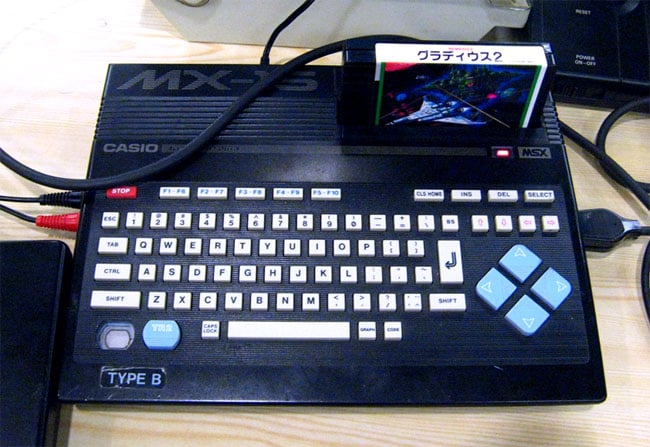
Casio’s MX-15
Source: Staffan Vilcans
And MSX itself was already moving on. A second-generation spec, initally called MSX-E, had been discussed as far back as the Japanese MSX launch in 1983, and by spring 1985, vendors were giving private views of their MSX 2 kit with its 512 x 212 hi-res graphics, 80-column text screen, and support for 256 colours and nine sound channels. The improved graphics derived from the addition of a Yamaha V9938 video chip in place of the TI 9918. A new version of MSX-Basic, MSX-Basic 2.0, provided extra commands to make use of the new facilities.
A now sound chip, also from Yamaha, the YM2149, replaced the original General Instrument AY-3-8910. MSX 2 supported 48KB of Rom to encompass an extra 16KB for disk or audio Bios extensions. The memory size was upped to a minimum of 64KB, and the video buffer to 128KB. The already selected 3.5-inch disk format may not have been mandatory, but it was certainly so widely used as to be a de facto standard.
Toshiba, said to have been the most successful MSX backer in Britain, in part thanks to its leadership of the MSX Working Group here, demo’d its HX-33 and HX-34 micros - the latter capable of connecting to a video disc player - though it insisted in public that neither would go on sale before Christmas 1985. Other vendors likewise pointed to an early 1986 launch.
The beginning of the end
In the event, most would not appear until Christmas 1986, if at all. Only JVC was interested, it seems, and planned to pitch its HC-95, a superior version of the HC-80 MSX 2 computer it demo’d in the UK in early 1985, against the Amiga, launched in the UK in 1986.
“I suspect it will not be seen at all as a low-cost computer,” warned JVC spokesman Peter Glas in May 1986. Indeed, it was around £1000. “This is a top-range model, which has only just been introduced in Japan. We want to re-instil excitement and enthusiasm about MSX, and we hope to sell it in the UK before the end of 1986.”
Sony, on the other hand, had “nothing planned for 1986, but out 1987 plans are more positive”, product manager Joe Yakota said at the same time. “Next year, we can initiate out CD-Rom with MSX for business applications... we’re looking at around Christmas 1987 to introduce that.”
But with stories of superior machines coming, not to mention the general slowdown in the home micro market and the imminent arrival of 16-bit home machines like the Amiga and Atari ST - both launched in the US in the first half of 1985 - MSX’s days seemed numbered. In July 1985, Dixons slashed its MSX prices by up to 50 per cent in a bid to shift them.
By September 1985, MSX User was quoting userbase figures of one million for Japan, but only 200,000 for the whole of Europe. Not that the MSX world lacked innovation: Spectravideo’s X’Press - aka the SVI-738 - incorporated a floppy drive, an MSX 2-level graphics chip and a carry handle: it was, in the autumn of 1985, the first luggable MSX machine.
Dixons early price cut seems to have puzzled MSX Working Group members, but by the autumn of 1985 they were doing to too, driving prices well below £100 by Christmas. For example, Toshiba’s HX-10 went from its £279 launch to £239, then to £139 and finally to just 79 quid, at which point Toshiba announced a £99 starter pack complete with HX-10, three software packages, a tape recorder and a blank tape, plus “plugs, fuses and even a screwdriver”. JVC cut the price of the HC-7GB straight from £279 to £100.
Toby Wolpe, Editor of Your Computer, called MSX’s UK Christmas a “rout”. That didn’t convince everyone, mind, with one Neil Alldritt, an Ad Manager on MSX Computing claiming that “MSX will succeed despite the current bad press and will be around long after the likes of Sinclair, Acorn et al have gone!” in a letter printed by Popular Computing Weekly.
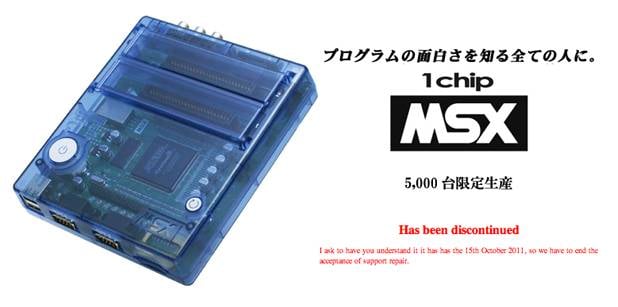
Penultimate revival: D4's One Chip MSX
MSX Computing hung around until 1987, longer than MSX itself did, in the UK at least. It never truly took off in the UK, where punters seemed keener on home-grown micros and American imports, not to mention the factionalisation that went with a host of incompatible rival formats. In the States, despite the Microsoft connection, the take-up was lower still, though that was as much because only two vendors - Yamaha and Spectravideo - released MSX machines there.
Like their British fellows, American computer users generally favoured native companies: Apple, Tandy, Texas Instruments, Atari and Commodore - even Sinclair’s partner, Timex, never made it big in the US.
Panasonic admitted in early 1986 that, having sold out of the stock of its MSX machines it had brought into the UK, it wasn’t going to import any more. By the end of the year, Sanyo, Sony, Mitsubishi and Toshiba were saying much the same thing. Yamaha was still in the game, continuing to push its MSX computers as music-making adjuncts.
Spectravideo, punching its machines out cheaply in Hong Kong, likewise continued to sell MSX machines here, though by now had its eye on the low-cost business computer market ignited not by Sinclair’s QL in 1984 but by Amstrad’s PCW series in 1985.
In Japan, however, demand was stronger, but ultimately doomed: the arrival of the Nintendo Entertainment System in 1986 shifted games-hungry kids away from computers to games consoles, and of course the dominance of the IBM PC platform in business computing. In the meantime, the platform continued evolve: in 1988 to a tweaked version of MSX 2 designed, said Kazuhiko Nishi in 1992, with the goal of making a “coloured Macintosh which cost under ¥100,000 and could come into home use”. It used a new GUI, MSX View.
The final iteration arrived in 1990: MSX Turbo R, based on the R800 CPU, an enhanced version of Zilog’s 16-bit Z800. Production of Turbo R kit is said to have ended in 1993 and had certainly stopped by 1995, even as Nishi, his chums at Ascii and hardware partners had their eye on reducing the cost of MSX further by integrating more of the functionality from many separate chips into just one or two.
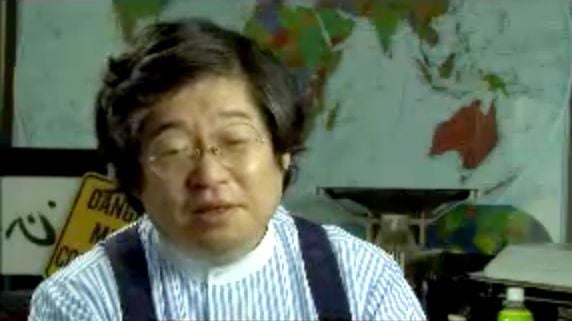
Kazuhiko Nishi in 2008
Source: YouTube
Such a part would eventually appear, sort of, forming the basis for a MSX-on-a-chip system released in 2006 by Japansed company D4 Enterprises. The chip was actually an Altera-made Field-Programmable Gate Array (FPGA). Looking a little like a cased Raspberry Pi, the “One Chip MSX” was MSX 2 compatible and packed in a pair of cartridge slots, VGA and composite-video output, an SD card slot for storage, and a couple of USB ports. D4 discontinued the product in 2011 - its MSX support now only extends to making old games available on the original Wii.
That year - 2011 - Russian firm Age Labs released GR8BIT ‘great 8-bit’, an MSX board computer “complete kit with rare components” including an “inactive MSX licence” for $499.
Nishi himself stopped working with Microsoft in 1986, finding its keenness to establish Windows as the world standard he envisaged MSX would provide not to his taste. He’s still involved with Ascii, but since 2001 he has maintained what is largely an advisory role, his career having at that point taken a more academic direction: he has MIT and Shoubi University professorships, and lectures at various Japanese universities on technology and society. ®
